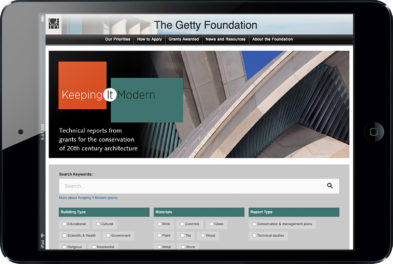Do you picture archaeological sites as dry, dusty piles of stones? Meet Peirene, an ancient Greek ruin so tantalizing that archaeologists have literally died for it. Dry and dusty this place is not.

Peirene: General view of the spring facade, with Acrocorinth (the acropolis of ancient Corinth) in the background. Histories of Peirene, Robinson (2011), Figure 3
The story of the alluring ruin is told in the book Peirene: A Corinthian Fountain in Three Millennia, recently published by the American School of Classical Studies at Athens. It’s the latest installment in Ancient Art and Architecture in Context, a series published with support from the Getty Foundation that focuses on the cultural and physical context of ancient Greek artworks and monuments.
Author Betsey Robinson, an art historian and archaeologist who came to classical studies via anthropology and evolutionary biology, takes us on a tour of the fountain through the lenses of history, literature, art, architecture, human geography, and topography, as well as the personal stories of the men and women who slowly chipped their way toward uncovering and understanding it.
Peirene began modestly, as a natural grotto supplying water for the settlement of Corinth. Built up slowly from about 500 to 100 B.C., it received an extreme makeover when the Romans came to town, gaining a grandiose façade, a great court, and an open-air basin the size of a swimming pool. By A.D. 100 its courts and passages gleamed with exotic marbles, richly painted scenes of tasty sea creatures, and sculptures including the bathing Aphrodite and Scylla the sea monster.

Peirene: Watercolor rendering by Robinson showing the polychromy that would likely have adorned the fountain’s spring facade. Histories of Peirene, Robinson (2011), Figure 100

Peirene: Interior view of Chamber IV showing (on the wall at right) remains of a fresco depicting water and sea creatures. Histories of Peirene, Robinson (2011), Figure 8
Peirene was more than just a fancy waterworks, though. Ancient cities worshipped their springs and rivers, which were personified as gods or nymphs, and for Corinth, Peirene was both sacred and social, a source of life and center of society. It was famed across the Mediterranean as the place where the mythical hero Bellerophon tamed his winged horse Pegasus, and of the dramatic scene in Euripides’ Medea where the tutor of Medea’s children overhears news of their impending exile from old men gossiping around the water.
Peirene’s glory was less lasting than the stories it inspired. The Roman city grew up around it, and successive Byzantine, Frankish, and Ottoman structures were built around, in, and finally atop it. By the Middle Ages the fountain was largely lost to view, which is how it remained until archaeologists from the American School decided to bring it back to light in 1896.
The fountain did not emerge without a fight. Work to reveal its vast labyrinth of cavelike chambers, reservoirs, and tunnels dragged on decade after decade and through the bombs of both world wars. Floods, collapses, and seas of mud bogged down the workers and outraged the villagers, who still drew the fountain’s cool, crystal-clear water.

“Mudmen” pose in front of Chambers I and II, on or about July 6, 1909. Histories of Peirene, Robinson (2011), Figure 54
And the water had a dirty little secret: contagion. The spring was plagued with contamination from nearby settlements and farming activity, and likely had been since antiquity. The waters and damp regularly felled workers and archaeologists with typhoid and malaria. Archaeologist Bert Hodge Hill, who battled both diseases, tried valiantly but fruitlessly to fix the pollution and secure safe drinking water for the villagers. At last, the man who made Peirene his life’s work was forced to conclude that it was, in Robinson’s words, “as much a curse as a blessing.”
Today, Peirene still lures those who would explore it and know more about its complex history—such as Robinson, who had been studying the site since graduate school. “To be working your way through these tunnels, with the water sweating out of the rock, feels very primordial and sublime,” Robinson told me. “Going inside is really exciting—and a little bit scary.” A great picture of her on the book’s back flap shows her newly emerged from a tunnel, wet, muddy, and wearing a miner’s lamp.
For her research, Robinson dove not only into tunnels, but also into the American School’s archives of the Corinth excavations, which are full of rich notes, sketches, and plans that helped her make several discoveries. For example, she redated Peirene’s courtyard to the 300s, two centuries later than previously thought, by marshalling records of digs from the early 1900s.
This finding casts a new light on Corinth’s vibrant late antiquity, a period often thought to have been sunk in a gloomy cultural twilight. It also reveals the growing potential of archive archaeology, the study of the past by excavating documents rather than dirt. Excavation archives “are really rich sites to ask new question and get new answers,” Robinson explained. “You don’t always have to be digging to be doing really exciting archaeology.”
You can do your own archive archaeology with the other volumes in the Ancient Art and Architecture in Context series: the first book, on an intricately detailed metal vessel known as the Derveni Krater, appeared in 2008, and titles on Macedonian monumental painting and at a frieze at Alexander the Great’s tomb are in the works.




Comments on this post are now closed.